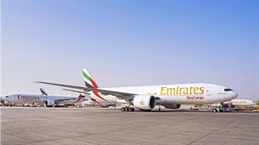
At a time when some carriers are accelerating the exit of freighters from their fleets, Emirates SkyCargo is pushing in the opposite direction. In early May, the Middle Eastern airline announced that it was leasing two Boeing 747 freighters to supplement its lift.
Wet-leased on long-term contracts, the two freighters complement Emirates’ fleet of 11 777 cargo planes. They are currently flying three times a week to Chicago and nine times a week to Hong Kong.
“The new aircraft means we can expand our freighter network and amplify the connectivity with the main Emirates network. The new fleet mix also gives us more flexibility to serve our different customers even better,” said Nabil Sultan, the divisional senior vice president of Emirates SkyCargo.
Another carrier expanding its freighter fleet is Air Canada, which took delivery of two 767-300Fs in early May. It has since added Punta Cana and Costa Rica to its all-cargo route network.
In the present market conditions, the two airlines are outliers. The slowdown in demand for air freight has prompted carriers to re-evaluate their freighter needs. Cargojet, Canada’s largest all-cargo operator, decided earlier in the year to postpone the conversion of two Boeing 777-300 aircraft and sell the planes with a view to acquiring conversion candidates closer to conversion slots later on.
In early May, management announced it had decided to sell a third 777-300.
“Cargojet is not immune to the softening industry trends and the macro factors of slower economic growth, higher interest rates and persistent inflation. Therefore, our team is focused on realigning every aspect of our cost structure with the current demand levels, including realigning our network, significantly improving productivity in our maintenance and operational areas, and cutting all discretionary expenditures while maintaining the industry's best on-time-performance,” said Cargojet president and CEO Ajay Virmani.
FedEx has been taking planes out of service. The integrator is restructuring its air network to save US$700 million yearly.
This involves retiring or parking aircraft, increasing point-to-point flying and relying on commercial airlines to move a growing portion of its traffic.
In the most recent quarter, it grounded nine freighters. FedEx is also accelerating the retirement of its MD-11F fleet, which should be gone by the end of the year.
UPS has gotten rid of its MD-10-30Fs and has indicated that it is moving to phase out its MD-11s.
While facing higher operating costs, carriers have seen their margins melt like snow in spring. The Drewry East-West Airfreight Price Index for April shows a 30% drop in the average airfreight rate from a year earlier. Average rates from Asia to Europe slumped 47%, while trans-Atlantic rates fell 56% year-on-year.
Airline load factors have dropped below 50% globally and in most of the major areas, according to IATA statistics. Part of the reason is due to the rise in bellyhold capacity as international travel is rebounding.
At the same time, demand has contracted as a result of weakening global economic indicators. Purchasing managers indices for the U.S., the Eurozone, and China have all sunk into contraction, pointing to continuing weakness in demand.
Moreover, shippers are feeling pressure to trim costs. This is prompting many to look to shifting traffic from airfreight to ocean transport, noted James Gagne, president and CEO of SEKO Logistics.
A comparison of airfreight and container freight indices shows a widening gap in pricing, which has grown almost fourfold since last summer.
At the same time, intermodal flows are not experiencing any significant congestion, giving cargo owners more confidence that ocean transit times are close to schedules.
Nevertheless, the spectre of disruption has not vanished. Concerns about a work stoppage at U.S. West Coast ports are one factor of uncertainty, but the experience in the past three years has made cargo owners and logistics providers wary of disruption.
“We want airlines to keep widebody lift in place, given uncertainty and disruption,” said Gagne. He added that some forwarders have decided to continue using a dedicated lift despite the drag on margins in the current market conditions. Neel Jones Shah, global head of airfreight at Flexport, remarked that freighter leases are longer-term arrangements bound to see fluctuations in profitability throughout the contract.
“We have to smooth it out over time and stay committed to our game plan,” he said.
Sultan stressed the longer-term perspective.
“While the current market volatility may cause others to hesitate, Emirates SkyCargo is pushing full steam ahead with our plans. The medium to long-term projections for global air cargo shows an upward trajectory of 3 to 5%. Combine Dubai’s strategy to double its foreign trade, where multi-modal logistics will play a big role, and the economic activity happening in markets around the Gulf, West Asia and Africa, the opportunity for Emirates SkyCargo is clear,” he stated.
Aircraft leasing firm Air Transport Services Group, which provides freighters for the likes of Amazon and DHL, also stresses the longer-term outlook.
In response to scepticism among financial analysts about its fleet expansion strategy following disappointing first-quarter results, CEO Rich Corrado attributed the lowered outlook mostly to the company’s passenger plane fleet and expressed confidence in airfreight demand.
“Our customers remain eager to lease the freighter aircraft we intend to deliver,” he said. “The persistent growth in online commerce throughout the world and the need to replace older, less efficient aircraft types means that midsize freighters will remain essential to global economic growth.”
By Ian Putzger
Air Freight Correspondent | Toronto



